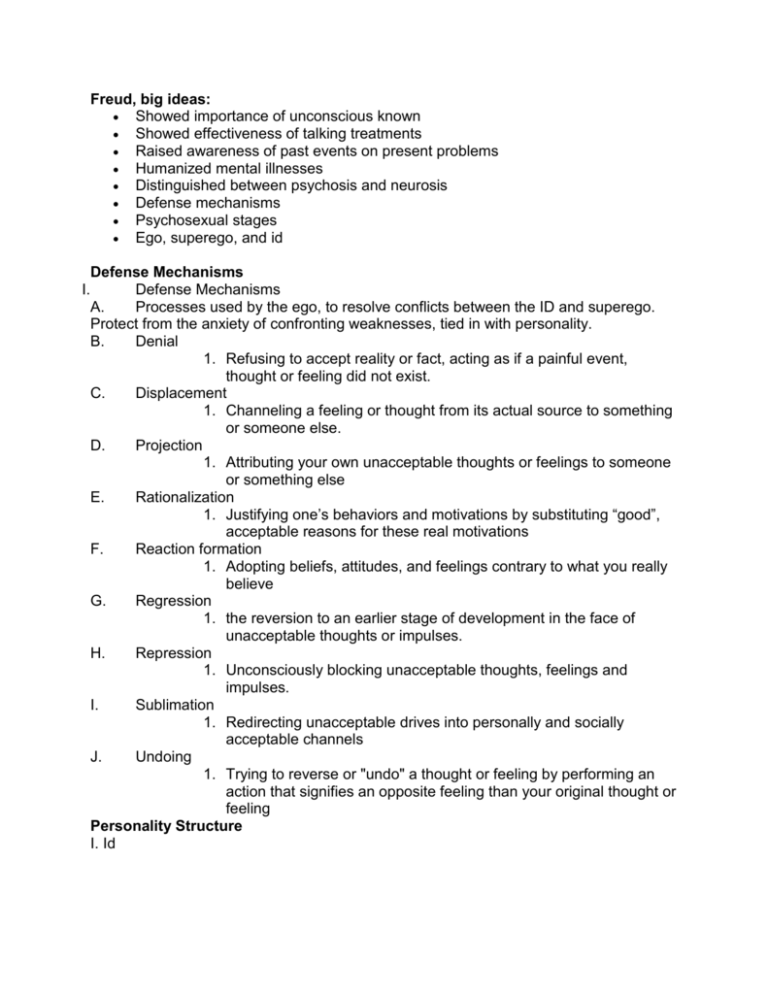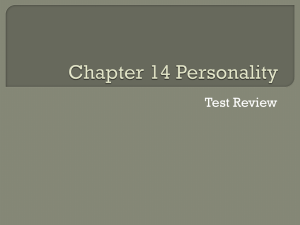
Freud, big ideas:
Showed importance of unconscious known
Showed effectiveness of talking treatments
Raised awareness of past events on present problems
Humanized mental illnesses
Distinguished between psychosis and neurosis
Defense mechanisms
Psychosexual stages
Ego, superego, and id
I.
Defense Mechanisms
Defense Mechanisms
A.
Processes used by the ego, to resolve conflicts between the ID and superego.
Protect from the anxiety of confronting weaknesses, tied in with personality.
B.
Denial
1. Refusing to accept reality or fact, acting as if a painful event,
thought or feeling did not exist.
C.
Displacement
1. Channeling a feeling or thought from its actual source to something
or someone else.
D.
Projection
1. Attributing your own unacceptable thoughts or feelings to someone
or something else
E.
Rationalization
1. Justifying one’s behaviors and motivations by substituting “good”,
acceptable reasons for these real motivations
F.
Reaction formation
1. Adopting beliefs, attitudes, and feelings contrary to what you really
believe
G.
Regression
1. the reversion to an earlier stage of development in the face of
unacceptable thoughts or impulses.
H.
Repression
1. Unconsciously blocking unacceptable thoughts, feelings and
impulses.
I.
Sublimation
1. Redirecting unacceptable drives into personally and socially
acceptable channels
J.
Undoing
1. Trying to reverse or "undo" a thought or feeling by performing an
action that signifies an opposite feeling than your original thought or
feeling
Personality Structure
I. Id
A.
The part of the psych according to Freud that is composed of unconscious
psychic energy that is used to satisfy instinctive desires. Governed by the “pleasure
principle”
B.
It operates on the pleasure principle, meaning it seeks immediate gratification.
C.
Driving force of the personality.
D.
According to Freud, children our driven entirely by the id/seeking of needs.
E.
Includes Death instinct (Thanatos)
II. Superego
A.
The part of the psych that is composed of our ideals that we get from society and
our parents.
B.
Works to suppress the desires of the id so that we behave morally, not
instinctively.
C.
In Freud’s theory of psychosexual stages, the superego develops last.
III. Ego
A.
The part of the psych that is the “mediator” between the id and the superego.
Finds compromise between instinct and moral urges.
B.
Operates on the reality principle, whether something is practical or not.
C.
Operates in both the conscious and preconscious (part of the conscious
associated with memory that is accessible).
Exploring the Unconscious
I. Unconscious
A.
The part of the mind people aren’t consciously aware of. Significant to Freud,
because he believed that the unconscious repressed unwanted feelings from our
awareness so that they wouldn’t influence us.
1. Contains the preconscious, which is the part of the unconscious that can be
recalled into conscious awareness, such as memories.
II. Psychoanalysis
A.
Freud’s theory of personality and his ways of treating patients based on the
question: Do neurological disorders have psychological causes? (ex. That blindness
might be caused by your unconscious not wanting to see something.)
B.
Attributes actions to unconscious conflicts and urges.
III. Free Association
A.
A psychoanalytic technique Freud used to explore the unconscious where he told
the patient to relax and say whatever came to mind, no matter how embarrassing or
trivial.
1. Through this, Freud believed he could trace back patients’ current problems to
root problems from their past, often from childhood by exposing “unconscious
tensions”.
IIII. Psychodynamic Theories
A.
After studying the unconscious through psychoanalysis, Freud got the idea of
psychodynamic theories: that humans behave as a result of the interaction between
conscious and unconscious urges, with an emphasis on childhood experiences.
Neurosis:
Result of conflict between superego and ID, represses desires of ID
Caused by internal impulses repressed by the ego, which find alternative
expression, or by external traumatic events.
Neurotic symptoms begin when a previously impermeable defense mechanism
breaks down and a forbidden drive threatens to enter the consciousness.
Psychosis:
Is carried away by the ID and detached from reality
Freud himself did not believe “the talking cure” could successfully treat people
with psychosis
Gender Differences of Freud:
The female has a less developed superego.
Penis envy leaves women unsatisfied,which causes feelings of inferiority.
Freud didn’t understand women.
Freudian Slip: When a person makes a misstatement, such as a mistaken word but
tells more information about what that person was thinking than the original statement.
Psychoanalytic perspective:
Focuses on the importance of the unconscious mind
The Development of Personality
I. Oedipus complex
A) Freud believed during the phallic stage boys had unconscious sexual desires for their
mothers and and anger/ jealousy toward fathers.
II. Identification
A) Eventually children would cope with their feelings developed during the Phallic
stage and identify with their rival parent. Here they would gain their parents values.
B) Freud believed that our relationships in early childhood developed our personality
and identities.
III. Fixate
A) Unresolved conflicts during childhood psychosexual stages could fixate pleasure
seeking energies developed during the stage. This could lead to needing to pacify the
fixation as an adult.
B) Someone who had an unresolved conflict during the oral stage may feel the need to
always chew gum as an adult.
C) Fixations in adulthood are seen as childlike approaches to gratify the impulses of the
Id.
Psychosexual phases:
5 stages of human development
The Oral Stage: Infant achieves gratification through oral activities (0-2) (fixation:
smoking, overeating)
The Anal Stage: The child learns to respond to some demands of society (2-3)
(fixation: orderliness, messiness)
The Phallic Stage: The child learns to differentiate males and females and
becomes aware of sexuality (3-7) (fixation: deviancy, sexual dysfunction)
The Latent Stage: The child continues development but sexual urges are quiet
(7-11) (fixation: none)
The Genital Stage: The adolescents learns to deal with the opposite sex (11adult) (all stages complete, person should mature sexually and mentally healthy)











